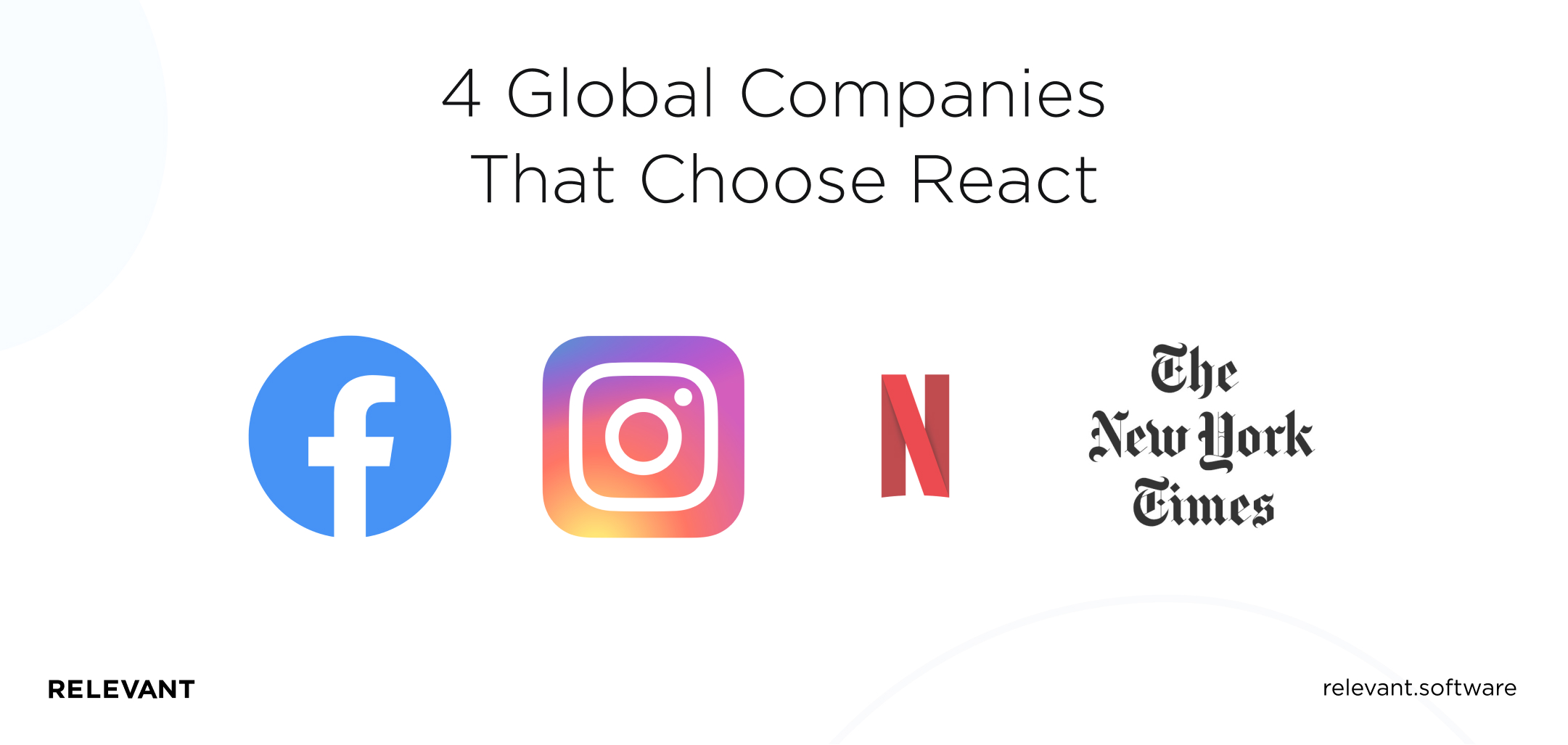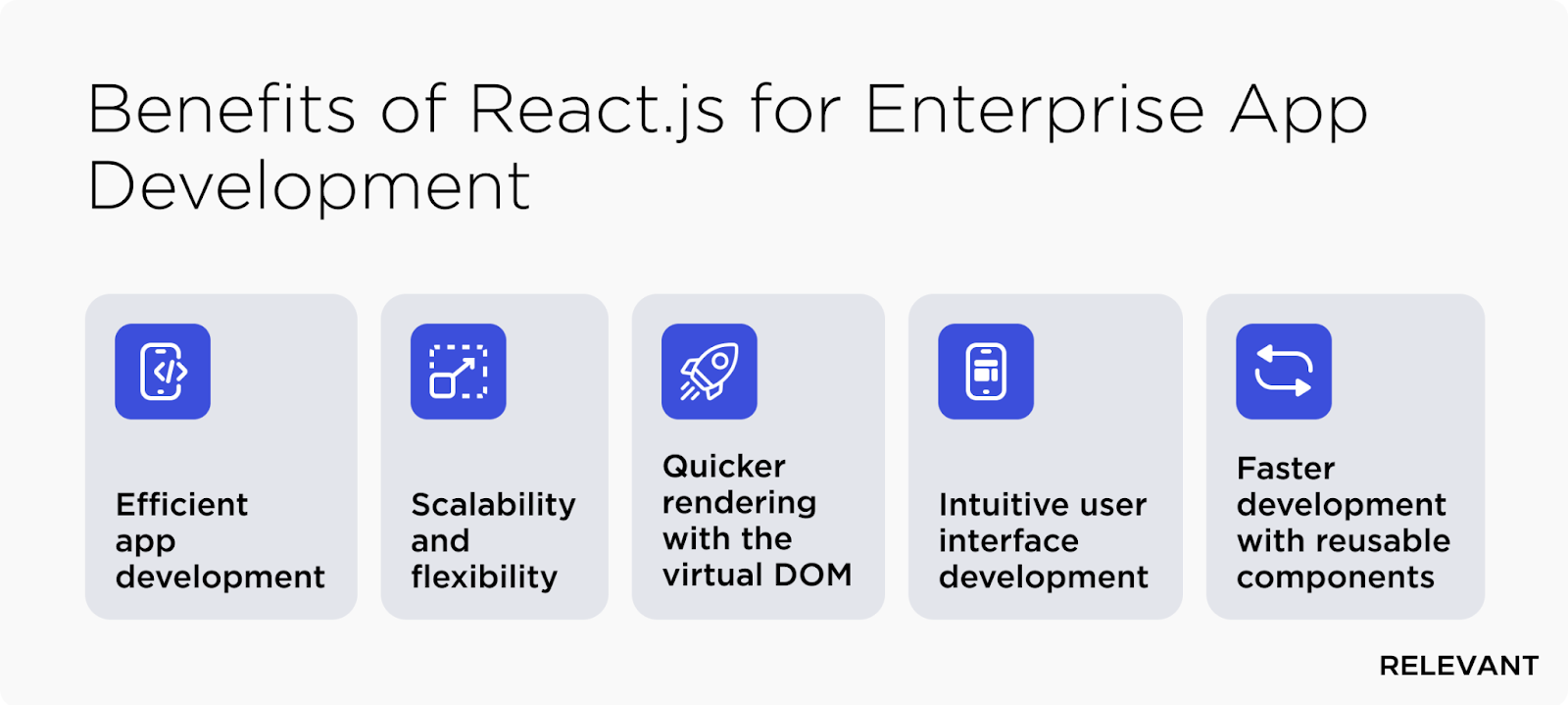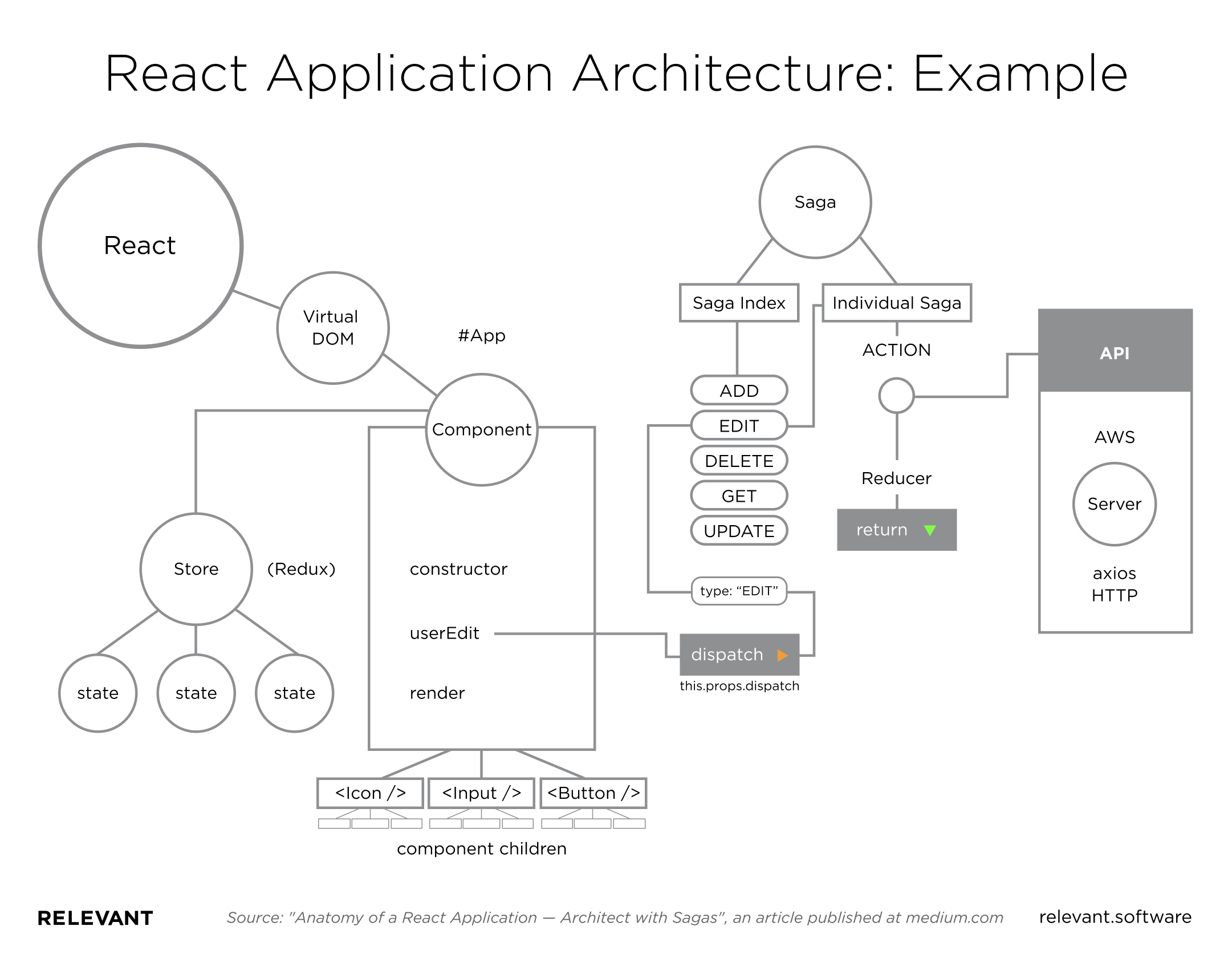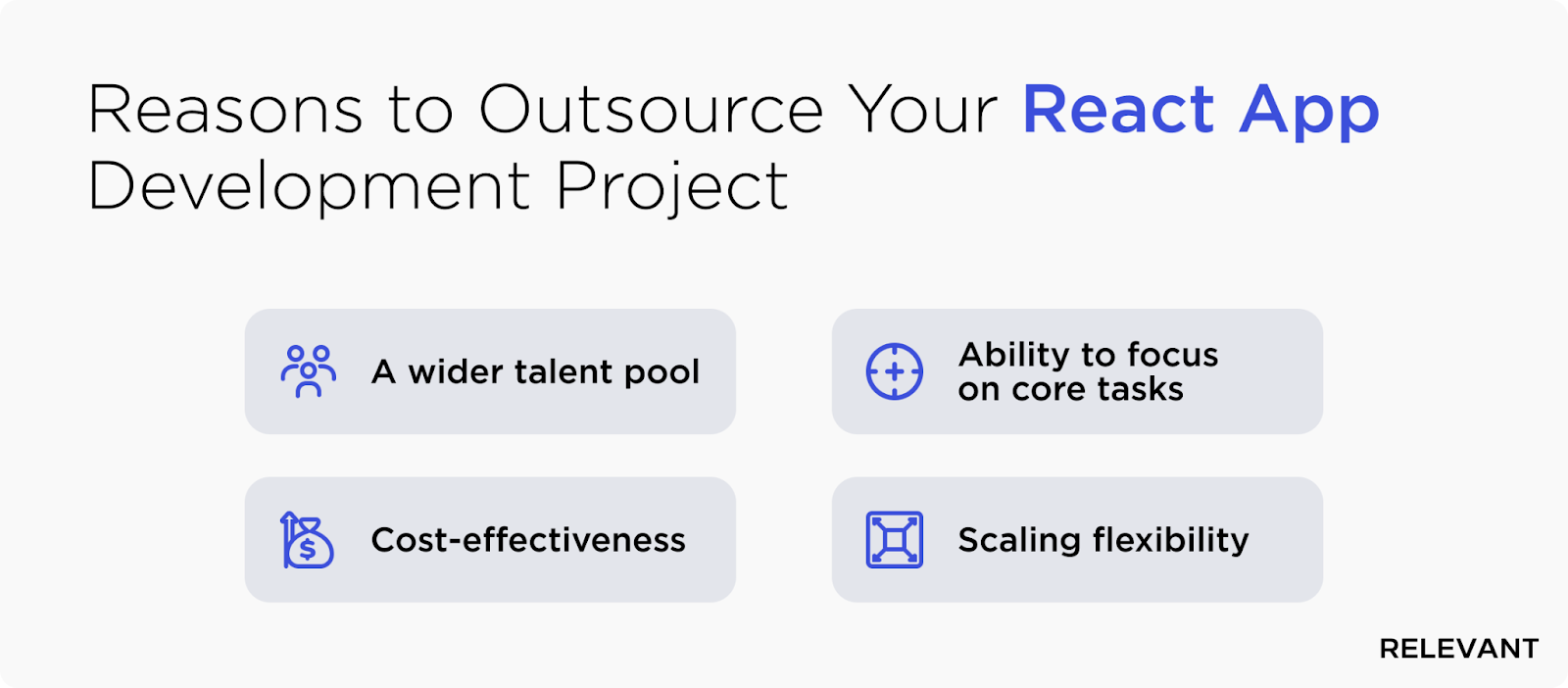Should You Choose React for Enterprise Application Development?
Updated: June 4, 2025
React is currently one of the most popular and loved tools for building modern web applications. At least 68.9% of React developers enjoy working with this library and intend to stick with it.
React’s popularity is on the rise because of its technical performance, flexibility, ease of testing, gentle learning curve, and multiple use cases. Building enterprise applications is one of them but would React enterprise application development fit your next project? Let’s look at the benefits of the library and some factors to consider before choosing React for enterprise app development.

We provide companies with senior tech talent and product development expertise to build world-class software. Let's talk about how we can help you.
Contact usTable of Contents
Why do big brands choose React.js for their development projects?
Building modern applications with React.js is the tactic both small and enterprise-level companies choose. Here are some examples of large applications built with React:
- Facebook. React was created by Facebook and is currently maintained by the company. Therefore, it’s no surprise that the tech giant’s website is built with React.
- Instagram. Instagram, which is owned by Facebook, also relies on ReactJS and React Native for the web and mobile versions of the app, respectively. Although both technologies sound similar, there is a great difference between React.js and React Native, and you are welcome to ask our React Native developers about the value-driving opportunities of the latter.
- Netflix. Netflix also uses React to improve its application’s load time, runtime performance, and modularity.
- New York Times. The New York Times is another app with React at heart. The company uses React to implement its Red Carpet Project, allowing users to browse a gallery of red carpet photos made during the Oscars ceremony.

Other popular web apps that utilize the React library include Dropbox, Codecademy, WhatsApp Web, and Khan Academy.
What kinds of solutions are usually built with React.js?
The developers can use React.js to build a wide variety of solutions, ranging from enterprise software to eCommerce custom web development. Below are some of the most common types of apps built with React.js:
- Single Page Application (SPA). React is often used to build Single Page Applications or SPAs. These are web apps that allow users to interact with data from the server without a page reload. Single Page Applications dynamically update web page content based on input from the user.
- Enterprise application development. Thanks to React.js component-based architecture, large projects can be broken down into smaller UI components. As a result, large companies, such as Walmart and Airbnb, use React.js as a part of their software development stacks.
- Data visualization dashboards. In response to the advancing capabilities of Big Data for business, many companies bet on React applications with data visualization features. ReactJS provides an excellent set of tools for building attractive and functional dashboards for data visualization.
- Social media and messaging apps. Social media and instant messaging apps follow the concept of a Single Page Application. That’s why many popular social media platforms, such as Facebook and Instagram, are built with ReactJS to provide a great user experience.
- eCommerce websites. eCommerce sites often feature functionality such as filters, advanced search, and APIs. ReactJS makes it easy for developers to implement these features and create conversion-driving online stores.
So, React.js software development capabilities aren’t limited to building enterprise software. However, it is still one of the leading use cases of this library. Let’s find out what precisely makes React.js a good option for creating enterprise solutions and how your project can benefit from leveraging this tool.
The benefits of ReactJS development for enterprise apps
Below are the main reasons React is a good option for enterprise software development:

- Efficient app development. React uses JSX (JavaScript XML), a syntactic sugar that allows developers to work with JavaScript as with simple HTML, keeping large pieces of code simpler. In addition, developers can create individual components and reuse them as needed throughout the application.
- Scalability and flexibility. One of the main benefits of architecting React applications is that the developers aren’t limited to strict architecture solutions. Instead, they can easily create a fully-custom business logic or leverage Flux – a pattern that manages data flow in a React.js app.
- Quicker rendering with the virtual DOM. React uses a virtual DOM for its components. As a result, apps built with the library are highly performant and efficient.
- Intuitive user interface development. React is easy to learn and use. It has a lot of developer-friendly documentation, and the component-based approach is straightforward.
- Faster development with reusable components. React allows development teams to save time by sharing and reusing components. Thus, they can build component libraries or even leverage generic components from commercial sources.
These are some solid reasons to use React, but there are also other libraries and frameworks to choose from. Let’s take a quick look at Angular.js – the second most popular technology for enterprise software development.
Angular vs. React for enterprise application development: Which is better?
Angular is a front-end web development framework that is commonly used to build complex enterprise applications. However, it has a steeper learning curve than React due to its wide range of built-in functionality. On the other hand, React is more lightweight and, thus, easier to get started with.
Unlike React, Angular forces developers to use TypeScript, a superset of JavaScript that comes with type checking. It also uses the real DOM instead of the virtual DOM and supports two-way data binding. When a new DOM is created, it compares it to the previous one and applies the differences to the “actual” DOM, only allocating memory if necessary. Angular also has a large community and powers several popular enterprise applications.
Overall, both Angular and React can be used to build large enterprise-grade applications effectively. It’s often a good idea to go with your dedicated development team’s option or whichever seems most suited for your project needs. You are also welcome to find out more about building enterprise applications with Angular, and we, in the meanwhile, will proceed with enterprise-level React application development tips and best practices.
Building enterprise React applications: The essentials
So, React.js can be a good choice for enterprise software development. Below are three essential tips to help you easily create an enterprise-level solution.
Think ahead about the core features
Enterprise-level software is usually complex. That’s why you should be very careful with the features you have to develop for an MVP. Lacking the most necessary ones will make the solution ineffective, while overdoing the MVP’s functionality will lead to poor decisions and increased development costs.
Below is the basic set of features for an effective enterprise app MVP:
- Multiple user roles with role-based access restriction
- Document management system
- Reporting and analytics
- Databases and existing apps integration
- Two-factor authentication
Pay double attention to the app’s design
Building enterprise software isn’t the only use case of React.js. Being ultimately flexible, this tool gives the developers all the necessary tools to create social media, eCommerce, and entertainment apps, but when designing an enterprise-level solution, you have to think from a business-driven and professional perspective. An enterprise app is one your employees will deal with daily, and one of its main goals is to increase their productivity, reduce errors and make it easier to work with huge amounts of data.
Despite the complex goals, an enterprise solution should still be easy and intuitive to use, streamlining employees’ onboarding, training, and everyday operations. That’s why there is less need to focus on aesthetics or fully align your app design with brand identity. Instead, you have to prioritize user experience over processes and follow established design patterns. For example, such enterprise apps as Microsoft BI, SalesForce, and QuickBooks can be valuable sources of design inspiration.
Ensure effective maintenance and scalability
As we have already mentioned, React.js allows software developers to implement fully-custom business logic. In the case of enterprise software development, it is a great advantage allowing you to build a solution carefully tailored to your business needs. However, too much flexibility in React.js can become a challenge when it comes to software maintenance and scaling.
To make it easier, make sure to organize the app components in a clear and logical way by creating dedicated folders for each type of the app’s data. For example, the files that are used by the entire app, like general configuration and set-up files, can be stored in the “General” folder, while the other components can logically be grouped according to the feature they belong to.

Best practices for scalable ReactJS enterprise app development
How the development process should go depends heavily on your project’s specifics. But there are a few practices that can help prepare your application for future growth.
Implement testing from the start
During the initial stages of a development project, writing automation tests might seem like a pointless chore since there are only a few components. However, if you want to build a scalable app, it’s vital to implement testing as soon as possible. Doing so will make it easy to continue testing as your codebase grows.
Leverage tools that can help you scale
While you shouldn’t add too many tools to your project, it’s a good idea to adopt valuable tools that can help you build a scalable app. These tools include Prettier, ESLInt, and libraries such as React Router, React Hook Form and date-fns.
Organize your project files properly
Organizing your project files properly and naming them logically will make it easier to manage them as your application grows. For example, it’s good practice to create folders for each component and place all related files, including the unit test file, in that folder.
Build a library for UI and logic components
Building a component library will allow the development team to share and reuse components. In addition, you can utilize a platform like a Bit to manage the collection. And also include logic in the library with hooks.
Use hooks to decouple components from the logic
Hooks are a feature of React that development teams can use to decouple logic from components. Developers can write custom hooks to share logic across components.

That’s all well and good, but there’s one last question to answer – are you going to build an in-house team with React developers or hire ReactJS developers from an outsourcing company?
Should you outsource your React app development project?
React.js development outsourcing is a wise choice for enterprises because of several value-driving reasons:
- A wider talent pool. Outsourcing a React development project gives you access to a wider talent pool. You can choose skilled developers from any location and benefit from lower tax rates. While you can recruit individual talent, hiring a software development team is an option to speed up the hiring process, bridge the talent gap, and get started with your project development faster.
- Scaling flexibility. Working with an outsourced team allows you to quickly scale the size of the team to suit your business needs best. For example, if you need to speed up the development process, you can hire additional specialists. You can also scale the team down and avoid overhead costs.
- Cost-effectiveness. Gathering an in-house development team can be pretty expensive, especially if you have no recruitment expertise and in-house project management experience. Hiring an outsourced team, in turn, is a cost-effective option for hiring remote developers since you can employ development talent from the location with the best price-quality match.
- Ability to focus on core tasks. Running an in-house development team requires staying involved in the project constantly. Outsourcing allows you to hand over those tasks to a development vendor so that you can better focus on your core business tasks.

React enterprise application examples: Relevant Software experience
A lot of growing companies have already outsourced their React.js enterprise development to stay more flexible and build powerful enterprise software. Here are some of the successful examples of how we’ve helped outsource ReactJS development:
Airthings
Airthings is a company that builds indoor radon monitoring products. We put together a dedicated team of ReactJS developers to help them build a dashboard that displays indoor air quality data from different locations.
GommeHD
GommeHD is a web portal for one of the largest Minecraft servers. We provided a dedicated team of ReactJS developers to help implement a modern design and deliver a feature-rich user experience.
FirstHomeCoach
FirstHomeCoach is a SaaS app that assists homebuyers in the UK with purchasing properties. We assembled a team of developers to build the app using ReactJS for the front end and Node.js for the back end.
Conclusion
React.js is one of the most performant and robust libraries for building powerful enterprise applications.
What’s more, this tool reveals its technical potential even better when handled by top-skilled React.js developers. Consider our React.js development services to gather a React.js team with deep and latest enterprise development expertise!
If you need to create an enterprise solution, you can outsource it to one of the experienced React software engineers at Relevant. We have highly qualified React developers and experience building scalable React enterprise applications.
FAQ
Our core services:
Do you want a price estimate for your project?
Do you know that we helped 200+ companies build web/mobile apps and scale dev teams?
Let's talk about your engineering needs.
Write to us











